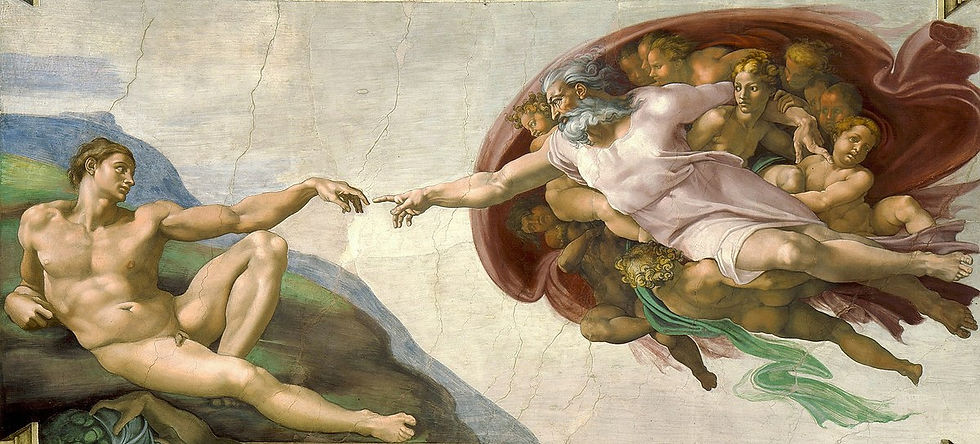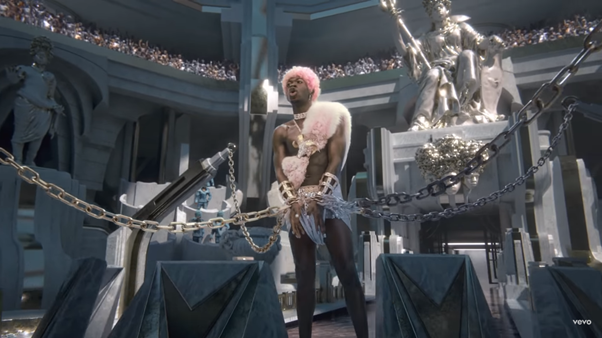LIL NAS X AND THE CLASSICAL TRADITION
- Yentl

- Mar 27, 2021
- 11 min read
Updated: May 15, 2023
I don't think it will surprise anyone that I'm writing this piece, honestly I tried to resist, I really did. But I can't stop thinking about Lil Nas X's new music video (as I am sure 99% of the population would relate to), and all the ancient history teasers he threw in there.
When I was learning ancient Greek at university, sometimes I woke myself up at night in a cold sweat, thinking "WHY was I SUCH an IDIOT to take this STUPID dead language?!". Well now I know why. It was to be able to understand the 5 second shot in the middle of possibly the best music video I've ever seen. Look I know I can't make excuses for this, but I do need to get it off my chest. So without further ado, let's jump right in - it's Lil Nas X, and the Classical Tradition, feat. Heracles, Medusa, Latin epigraphy, and a whole bunch more.
But let’s start at the beginning. This image Lil Nas X shared announcing the Montero (Call Me By Your Name) release.

This is such a great place to start this discussion, because it brings in a whole bunch of Classical imagery, and really demonstrates the path that the music video is going to take. The poses of both figures deliberately mimic the ‘Creation of Adam’, a fresco painted on the ceiling of the Sistine chapel by the Renaissance painter Michelangelo, in which we see God reaching down from the heavens to Adam, the first human.

These religious themes, particularly of the relationship between the mortal and the divine, will continue throughout the Montero video, and so this is a particularly significant image to begin with. This allusion is even more impactful however if you consider the context of the original fresco. Michelangelo is remembered for his gay relationships, which brought him into conflict with certain religious officials at the time, and much has been written on the homoerotic imagery of the Sistine Chapel – I mean his ‘Last Judgement’ fresco even shows a pair of men having a cheeky snog in heaven. In fact, Michelangelo’s sexuality and religious beliefs have always been closely interlinked – in one of many love poems written to his lover Tommaso dei Cavalieri, he states that through his love for men, he loves God.
This link with the Queer and the Divine is only emphasised through the strings tied around the two figures. In Greek mythology, the Moirai (often called the Fates) basically controlled people’s fates through string (if you’ve seen Disney’s Hercules, remember those old biddies with the scissors? that’s them!). One of the big parts of the mythology around the Moirai however was the fact that they controlled the lives of both humans, and the gods, which is emphasised in both the red and white strings leading to the mortal and the divine. And let’s talk more about this divine Lil Nas X – poised with the bow and arrow, he looks like the perfect Eros (or Cupid to the ancient Romans!). Now Eros, the son of Aphrodite, is celebrated as a god of desire and sexuality, and in some traditions becomes a deity associated with homoeroticism. Another really interesting story about Eros however is his relationship with Psyche, a human woman – one of the only Greek myths where a human and a god actually have a pretty happy ending. See in Greek and Roman myth, gods and humans don’t go together, the human pretty much always ends up dead (or transformed into an animal/vegetable/mineral), because the idea of a divine/mortal relationship goes against nature, they’re incompatible. Eros/Cupid and Psyche however completely turn this narrative upside down – not only do the supposedly unnatural pair end up together, but their actions consistently go against typical gender roles, with Psyche taking the role of the heroic champion earning the love of Eros. This inversion of heteronormative approaches to gender, sex, and sexuality acts as an introduction to the artistic masterpiece Lil Nas X is about to reveal.
So moving onto the video itself! As the camera pans over a ruined landscape, we fly past the remains of a Doric temple. Now I’ll be honest with you, I literally spent about an hour wracking my brain trying to find a temple that had a pediment (the triangle bit at the top!) with the sculpture shown here – I can’t think of one! So please if you’ve figured this out, comment below because it is KILLING me. Interestingly in Ancient Rome, Doric columns (the ones you can see here with the plain top) were associated with masculinity and manhood. If we wanted to get seriously English GCSE style analytical here, you could argue that we’re flying past the ruins of traditional masculinity, but hey, maybe I need to calm down with this! The shot continues however, and we fly past what looks like a ruined viaduct, with a monumental sculpture in the background. Viaducts were a major part of Roman expansion, used to transport water across their territories. They actually formed a really interesting part of Roman propaganda, where the Romans considered them to be proof that they had conquered the ‘savageness’ of the natural world, by bringing water to where it hadn’t been before. It’s an interesting dynamic to see these symbols of the ‘creation of order’ destroyed, reminiscent of the ideas of Queer disordering and the revolution of heteronormativity. This is only further emphasised by the monumental sculptures, which evoke not only the self-aggrandization of Roman emperors, but is also reminiscent of the poem Ozymandias, written by the (arguably Queer) Romantic poet Percy Shelly, in a reflection of the pride of royalty and the ruling class, and their eventual downfall. This idea of hubris and eventual downfall is deeply rooted in Graeco-Roman mythologies, but also reflects teachings of Christianity, particularly Catholicism, returning to the earlier motif of the divine.

This divine image is only emphasised as we follow the path of a snake across to a tree, immediately reminiscent of the biblical story of Eve, the snake, and the tree of knowledge, bringing with it ideas of temptation and gender. But before we discuss that I want to briefly mention the shot of Lil Nas X seated with a guitar at the base of the tree.
The combination of his long hair, beautiful appearance, and the arguably effeminacy of the pink guitar marks a strike contrast to the threatening figure of the snake approaching from behind the tree, and casts Lil Nas X as a beautiful, innocent, feminine figure, arguably being hunted. The effeminate musician however also lends itself to Bacchic comparisons, particularly to the god Dionysus. The Greek god Dionysus was celebrated for his roles in sexuality, pleasure, and gender non-conformity (check out my previous article on this if you want to know more!!), and so by associating himself with him, Lil Nas X effectively alludes to the Bacchic extravaganza that we’re about to see.
Now let’s return to the snake. The obvious take here is Biblical – that Lil Nas X takes the form of Eve, with the serpent, i.e. the devil, descending to tempt her/him. The snake also however in ancient world was associated with the character Asclepius, who learnt the secret of immortality from a pair of snakes, and was later killed by Zeus to prevent him from spreading the secret to the world of men – he tries to overcome the divide between mortal and divine, and is killed for it. Thanks to this mythology, not only can snakes be seen to represent temptation, but they are also symbolic of the destruction of the ‘natural order’, going against the traditional norms and rulings of society.
As well as this, in Classical tradition the snake is often linked with the god Apollo. Now Apollo is kind of a tricky character – the fact that he was the deity of music, the sun, and poetry makes him seem like a pretty ideal figure? But you know what he was also the god of? the plague. Just like the plague, he’s usually horrifically shitty. we often see him characterised as a sexually aggressive predator – pretty perfectly represented here in the snake pursuing the fleeing innocent portrayed by Lil Nas X.
As he runs, we see what appears to be a figure surrounded by branches and foliage, reminiscent of the character Daphne, who was transformed into a tree in order to escape the clutches of Apollo. As Lil Nas X continues to walk, we see faces emerge from the flowers, potentially representing Hyacinth, yet another mortal who Apollo became obsessed with, which ended in the death of the young man, and his transformation into a flower. The chase scene culminates in a Python-esque figure staring into the eyes of Lil Nas X in a display of hypnotism and control, reminiscent of both the encounters between mortals and divine in Classical tradition, but also arguably reflective of the character Medusa – a theme we’ll return to later.

As the camera pans away, we see an inscription carved in ancient Greek, which I’m not gonna lie, really tested my rusty translation abilities. The passage comes from Plato’s Symposium (Google plat. sym. 191 to read the translation!), where he talks about how humans were split in two by Zeus, and now search the world to find their other half. Now this is particularly significant not only because it brings in the whole divine/mortal relationship again, but because that passage of the Symposium is part of a greater theme talking about the superiority of gay relationships, and was an early attempt at rationalising why different sexualities exist. It’s a really nice touch that adds a deeper more emotional level to this piece – a nod to the long history of Queer love, and the homoeroticism of antiquity, that too often is erased by heteronormativity and societal homophobia.
But now the scene changes, and we’re watching Lil Nas X brought in chains to a figure in blue with inCrediBLe hair. This same hairstyle became hugely popular in the Flavian period of Ancient Rome, where long curled hair became synonymous with femininity and passivity (– so women, and bottoms). But this hair was also really important to the women of the period, because it symbolised their increasing public involvement within society, and really demonstrated their growing power. With this however came an increase in sexualisation by men, with Roman authors complaining about how horny Roman matrons were – evidence of that age old link between gender, power, and sexuality.

Returning to the central character, we see Lil Nas X this time outfitted in pink, with a faux fur drape across his chest, appearing like the hero Heracles (/Hercules), being brought forward in chains. This image of Hercules in chains appears again and again in popular culture, but the ancient figure of Heracles is actually a really interesting case of non-normative gender expression in the ancient world.
See, not only do we have a really tragic Queer love story between Heracles, and his lover Hylas, but we also see atypical representations of gender during his defining mythologies. At one point during Heracles’ labours he encountered the queen of the Amazons, and spent time with her, at which point he ‘took the female role’ in their relationship, dressing in women’s clothes, and becoming the passive figure, completely subverting gender expectations. In fact you see this celebration of male femininity in the Roman general Marc Antony, who consistently aligned himself with the gender-bending deities Dionysus and Hercules, while rejecting traditional norms of gender and culture. As the crowds cheer around the central Heracles figure, this link with Roman culture is emphasised through the amphitheatre imagery, casting Lil Nas X as the unlucky gladiator who is soon killed by pelted rocks.
Cue the ascension – Lil Nas X rises towards the heavens, a physical embodiment of what it means to be both Queer and Divine. As he soars towards the skies we see another winged figure silhouetted against the sun - is it an angel? Or is it the sun himself, Apollo, leaving Lil Nas X as the figure of Icarus, who flies higher and higher towards the heavens until he is struck down by the gods for his pride, and for attempting to transgress the limitations of his mortality. Either way, he doesn’t make it up there to join the angel, but instead we get THAT pole scene.
If anyone can pay attention to the backdrop instead of the incredible athleticism of Lil Nas X here, I salute you. As he flies down the pole, we see him descend back down through the amphitheatre, emphasising the spectacle that we are all witness to. As he slides further, we see reliefs around him that wouldn’t seem out of place on the walls of Trajan’s column – a triumphal depiction of the emperor Trajan’s victory in the wars against the Dacians. And then we arrive at Hell, or if you want to stay Classical, at Hades. Now this effectively forms a katabasis, or a descent into the underworld, which is a major part of the heroic narrative in global mythology, and particularly emphasised in Graeco-Roman literary tradition. Heroes like Heracles, Orpheus, Odysseus, Aeneas, Theseus, (and Psyche!) all descend to the underworld as part of their narrative arc, before finally emerging victorious. Now it's also worth mentioning that these same heroes are currently loved by the alt-right, who celebrate them as this (false!!) example of white heterosexual hypermasculinity (as we're seeing on Twitter literally right now). For Lil Nas X to then embody this heroism, becoming the viewer's hero, as we watch him complete this ancient mythological test of greatness is not only an immensely beautiful and erotic part of the music video, but also becomes a celebration of Black excellence, as well as a two fingers to the racist alt-right who want to claim Greek heroes for their own.
And then he walks into the palace of hell. Statues on either side of the door resemble the ancient sculptor Polykleitos’ Doryphoros – the spear bearer, which was created to represent the ideal man, a fitting tribute to the creator of this epic work of art. As Lil Nas X approaches the throne, we see monumental sculptures carved into stone pillars, with their glowing eyes and coiled hair seemingly symbolising Medusa and the gorgons, often considered monstrous both in antiquity and throughout later history – is it any wonder that alongside Lil Nas X in hell we see depictions of these powerful women?

And then we meet the devil. Seated on a throne, with a similarly Medusa-esque portrait behind him, Satanic imagery blends with Classical symbolism to create a deeply evocative scene. A Latin inscription at the base of the throne reads Damnant quod non intelligunt – They condemn what they do not understand, a line that manages to retain its emotive nature even as Lil Nas X gives a lap dance to the Devil. And what a performance it is. Honestly I don’t really have words for this other than you should definitely definitely watch it multiple times.
As the dance finishes, we see Lil Nas X kill the Devil, and take his crown, in a beautiful portrayed display of sexuality and power. He gains the wings that he would have needed to reach the heavens earlier in the narrative, and has defeated the ruler of the underworld, therefore completing his heroic narrative. As he places the crown on his head, his eyes glow – again evoking the mythology of Medusa, and the gender empowerment and simultaneous threat to patriarchal norms that has historically relegated her to the role of ‘monster’.
And that’s how the video ends. And what an ending. Honestly this is one of the best artistic performances I think I’ve ever seen, and as someone who identifies as both Queer, and Christian, the relationship between religion, and LGBT+ experience brings greater significance and importance to this outstanding performance. Evoking the spirit of Medusa, and the refusal to be silenced that she has come to represent, Lil Nas X doesn’t just refuse to hide his sexuality, he openly flaunts and demonstrates it in this beautiful Bacchic performance celebrating the power of queer identity and sexuality. The repeated Classical motifs that are too often embraced by the far right are beautifully employed here, reflecting the Queer, polychromatic, hypersexual Antiquity that is so often whitewashed.
I actually want to end on that Latin inscription: Damnant quod non intelligunt – They condemn what they do not understand. The beautiful simplicity of this ancient quote in the larger artistic reflection of gender, sexuality, and what it means to be divine perfectly embraces the Queer audience, whilst simultaneously challenging those who seek to attack them, and who will no doubt attack Lil Nas X’s performance here. It reflects both antiquity and the continued struggle of minorities in today’s culture, and is a perfect ode to the tradition of Classical Reception.
Honestly, Montero (Call Me By Your Name) made me glad I study Classics.











Loved this blog post.
Say
I have a blog at www.intelagent.wordpress.com. I would be honoured if you could do to one of my blog posts what you do to your own (I personally suggest "Sol Invictus" but check them out for yourself). Give it a much needed shade of classical enlightenment.
With regard to the pyramid, I'm all about believing it is the ultimate symbol for hierarchy. With snakes symbolizing the up-downs therein that characterise the wave nature of reality, the archetypal hero's journey, etc.
I'm sort of a sci-fi guy but I think we can team up. What do you think ?